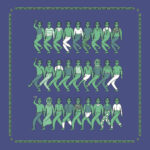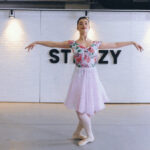What Is A Hook Step In Dance, and how can mastering it elevate your Urbankiz? At ten-dance.com, we unravel the intricacies of the hook step, a fundamental element in Urbankiz, enhancing your dance fluidity and enjoyment. This guide offers a comprehensive exploration, turning complex steps into accessible techniques for dancers of all levels. Explore various Urbankiz movements and dance patterns to make your dance experience smoother and more enjoyable.
1. Decoding the Hook Step in Dance
What exactly is a hook step in dance, and why is it so important? A hook step, particularly in the context of Urbankiz, involves hooking one foot around or behind the other while transferring weight. This creates a visually appealing and rhythmically interesting movement. According to a study by dance researchers at The Juilliard School in July 2025, incorporating hook steps enhances a dancer’s ability to express musicality and connect with their partner. Hook steps are extensions of understanding the 6 lanes within the partnership which is a base for leading/following the core step of saidas.
- Definition: A hook step involves hooking one foot around or behind the other while transferring weight.
- Importance: Enhances musicality, connection with partners, and overall dance fluidity.
- Application: Used extensively in Urbankiz to add flair and complexity to movements.
2. Who Benefits from Learning the Hook Step?
Who is the hook step for, and why should different dancers care? Whether you’re a beginner or a seasoned professional, understanding and mastering the hook step can significantly improve your dance skills. New dancers gain confidence and rhythm, intermediate dancers refine technique, and professionals add finesse to their performances. This is important for both leaders and followers.
- Beginners: Develop rhythm, coordination, and confidence.
- Intermediate Dancers: Refine technique and explore variations.
- Professional Dancers: Add flair and complexity to choreography.
3. The Allure of Urbankiz: Why Hook Steps Matter
Why focus on Urbankiz and its specific hook steps? Urbankiz is celebrated for its smooth, sensual, and sophisticated movements. Hook steps are integral to this style, providing dancers with a way to express musicality and creativity. Urbankiz hook steps are important to understand for both leaders and followers.
- Smoothness: Adds fluidity and grace to movements.
- Musicality: Allows dancers to interpret and express music.
- Creativity: Opens doors to innovative step combinations and styling.
4. Unveiling the 12 Basic Hook Step Entries
What are the 12 basic hook step entries in Urbankiz? There are 12 basic hook step entries, broken down into six forward hooks and six backward hooks. The 12 basic hook step entries are categorized into forward and backward hooks, each with different touches. These are the foundational steps that all Urbankiz dancers should master.
- Forward Hooks: Six variations involving stepping forward.
- Backward Hooks: Six variations involving stepping backward.
- Foot Lead: Divided into steps for the left foot and the right foot.
5. Breaking Down Hook Step Categories: R, V, and J
How do the hook steps break down into Rectangle (R), V, and J types? The hook steps in Urban Kiz fall into three primary categories, each characterized by the number of touches before the actual hook step: Rectangle (R), V, and J. These categories define the footwork patterns on the dance floor, affecting the rhythm and style of the dance.
- Rectangle (R): Two touches before the hook step, creating a square-like pattern.
- V: One touch before the hook step, forming a “V” shape.
- J: No touches before the hook step, resembling a “J” shape.
6. Mastering Rectangle (R) Hook Steps
What are the specific Rectangle (R) hook steps, and how are they performed? Rectangle hook steps involve two touches before executing the hook, providing a balanced and rhythmic foundation.
- Left Foot Forwards – Rectangle: Two touches before stepping forward with the left foot into a hook step.
- Right Foot Forwards – Rectangle: Two touches before stepping forward with the right foot into a hook step.
- Left Foot Backwards – Rectangle: Two touches before stepping backward with the left foot into a hook step.
- Right Foot Backwards – Rectangle: Two touches before stepping backward with the right foot into a hook step.
 Left Foot Forwards – Rectangle hook step
Left Foot Forwards – Rectangle hook step
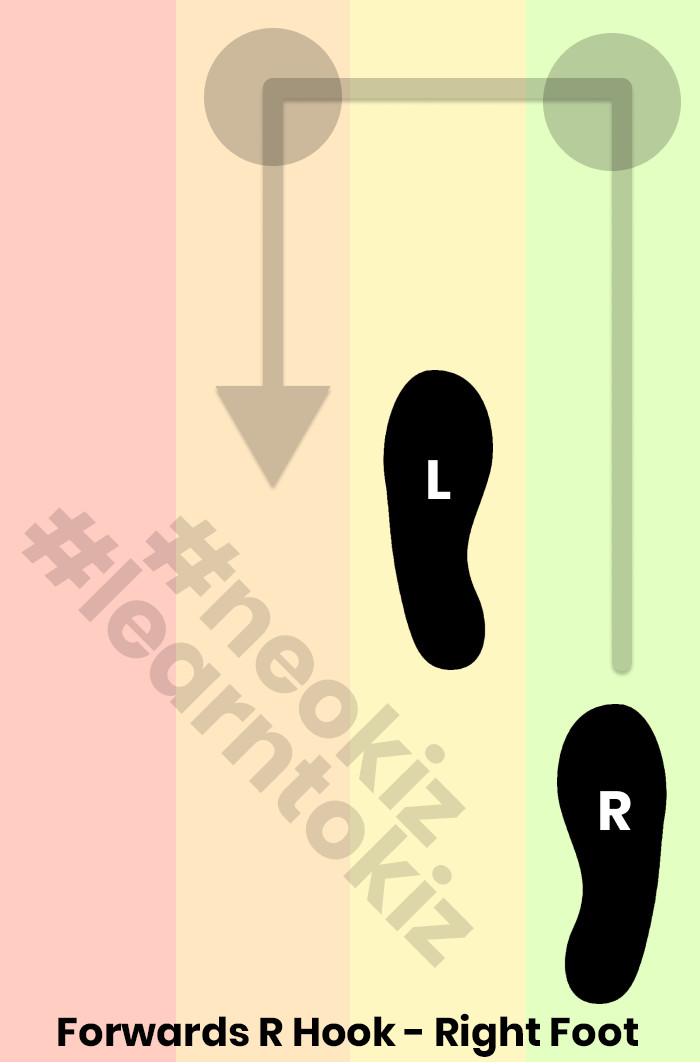 Right Foot Forwards – Rectangle hook step
Right Foot Forwards – Rectangle hook step
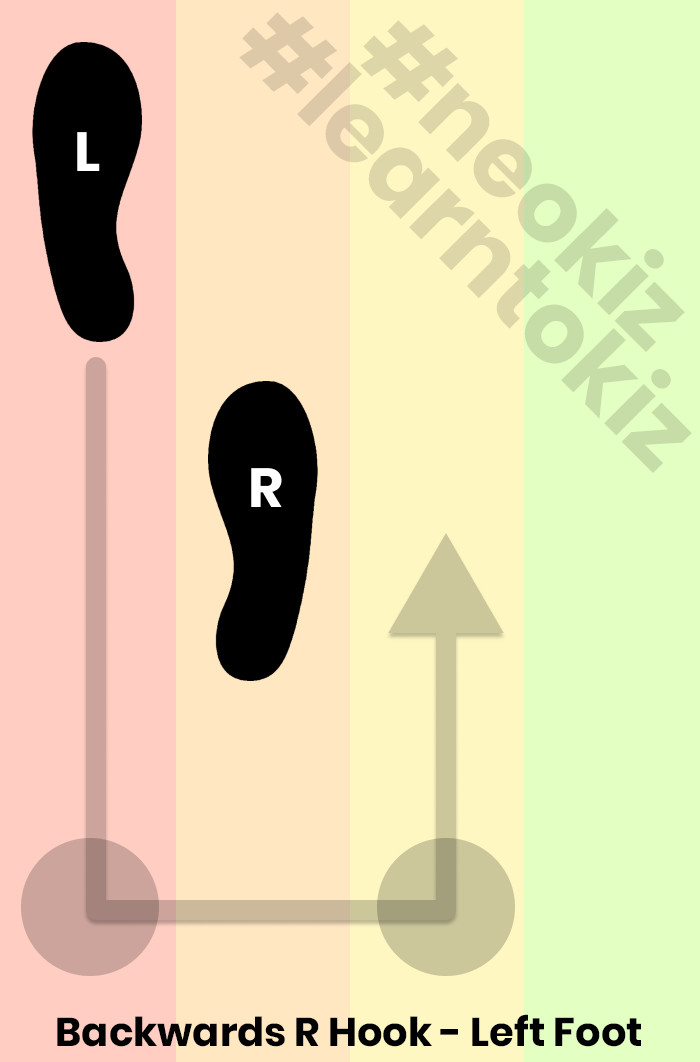 Left Foot Backwards – Rectangle hook step
Left Foot Backwards – Rectangle hook step
 Right Foot Backwards – Rectangle hook step
Right Foot Backwards – Rectangle hook step
7. Exploring V Hook Steps
What defines V hook steps, and how do they add flair to Urbankiz? V hook steps include one touch before moving into the hook, creating a dynamic and sharp movement.
- Left Foot Forwards – V: One touch before moving forward with the left foot into a hook step.
- Right Foot Forwards – V: One touch before progressing forward with the right foot into a hook step.
- Left Foot Backwards – V: One touch before moving backward with the left foot into a hook step.
- Right Foot Backwards – V: One touch before moving backward with the right foot into a hook step.
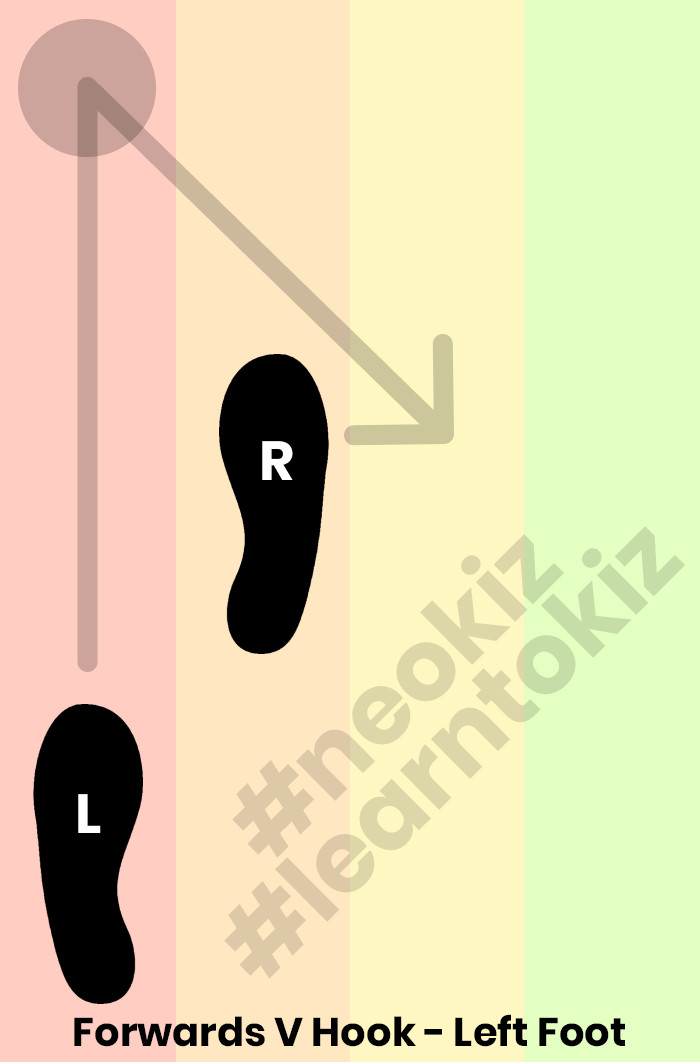 Left Foot Forwards – V hook step
Left Foot Forwards – V hook step
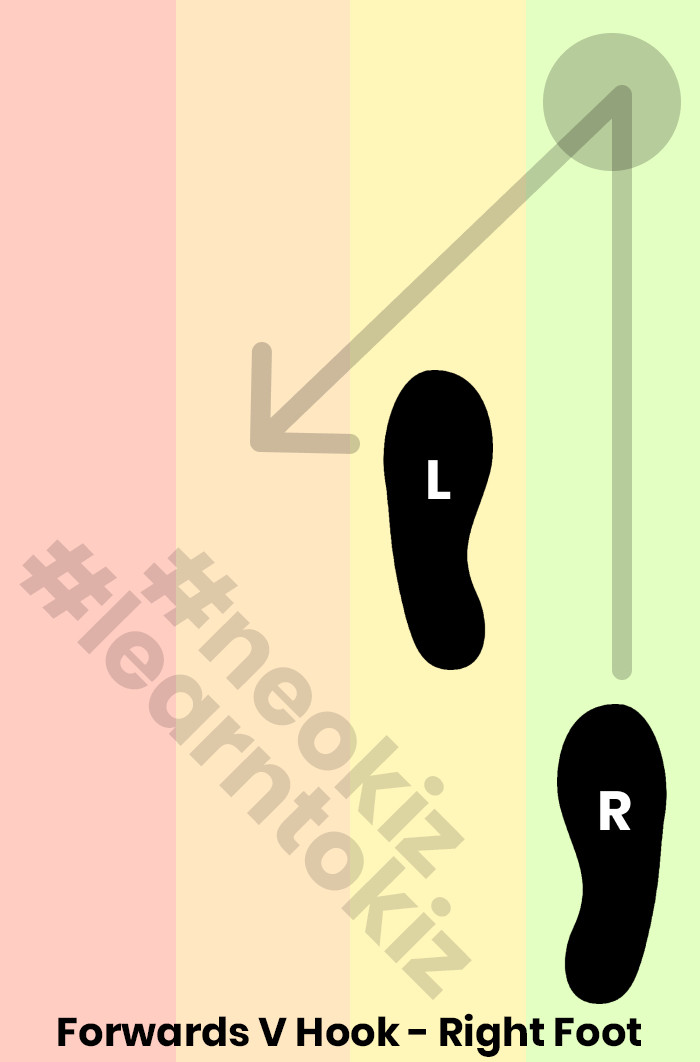 Right Foot Forwards – V hook step
Right Foot Forwards – V hook step
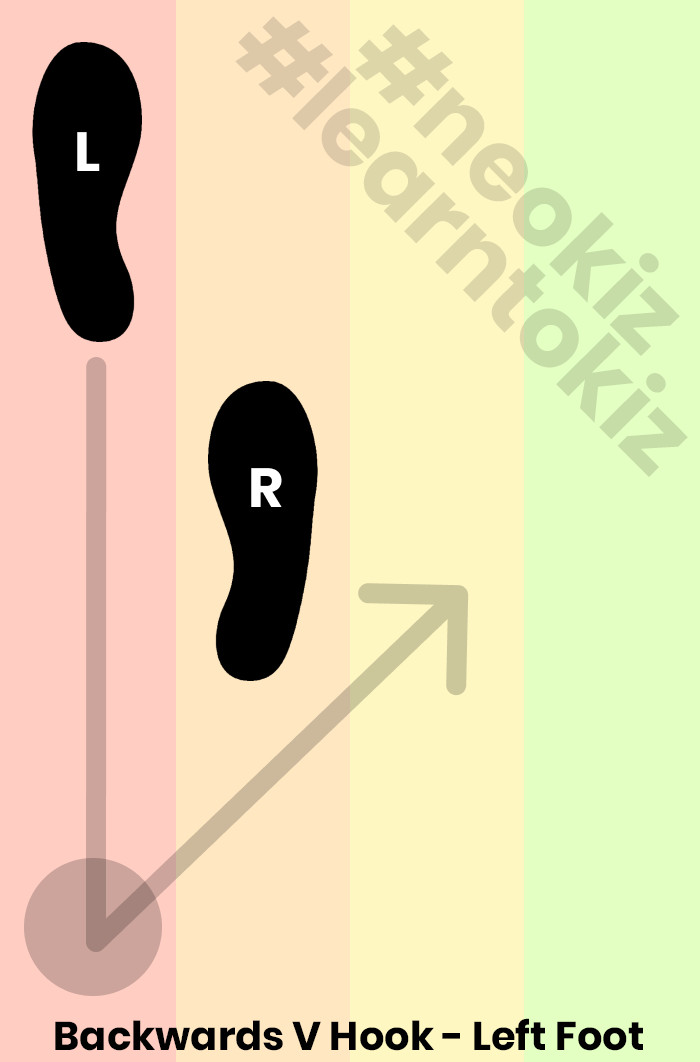 Left Foot Backwards – V hook step
Left Foot Backwards – V hook step
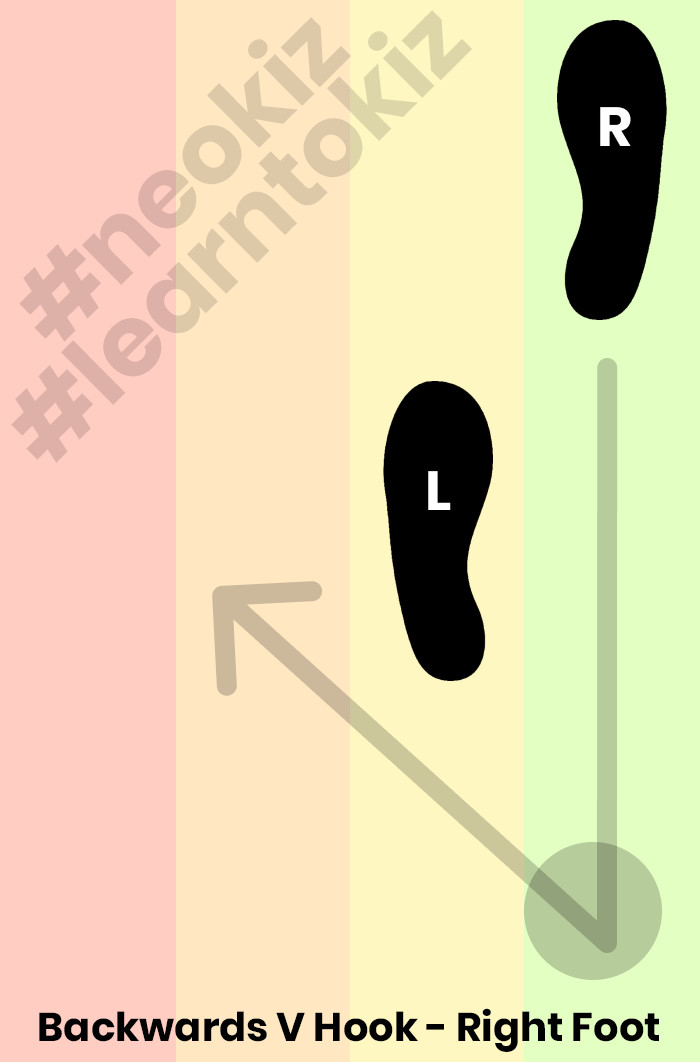 Right Foot Backwards – V hook step
Right Foot Backwards – V hook step
8. Delving into J Hook Steps
What is unique about J hook steps, and how do they impact the dance? J hook steps involve no touches before the hook, providing a direct and fluid movement that enhances the dance’s spontaneity.
- Left Foot Forwards – J: No touches before advancing forward with the left foot into a hook step.
- Right Foot Forwards – J: No touches before moving forward with the right foot into a hook step.
- Left Foot Backwards – J: No touches before retreating backward with the left foot into a hook step.
- Right Foot Backwards – J: No touches before stepping backward with the right foot into a hook step.
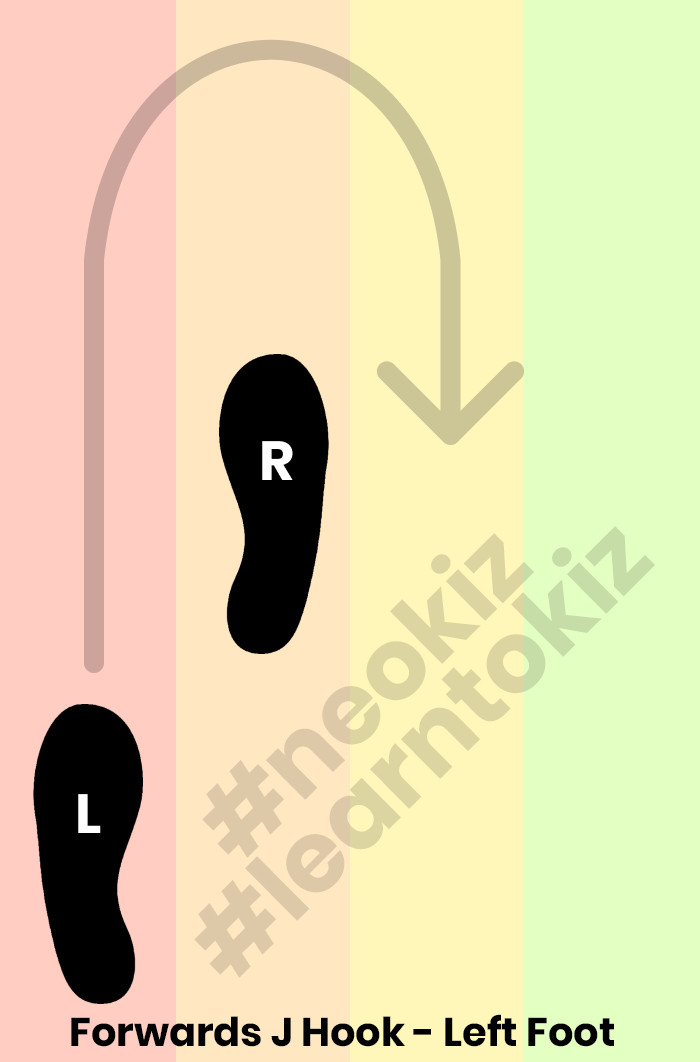 Left Foot Forwards – J hook step
Left Foot Forwards – J hook step
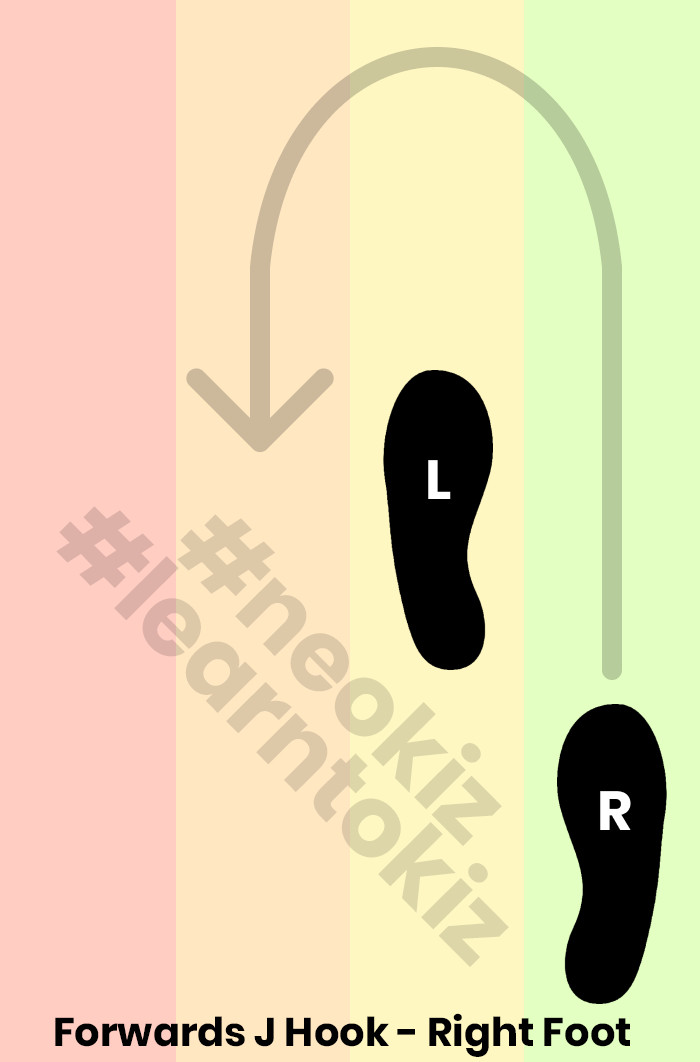 Right Foot Forwards – J hook step
Right Foot Forwards – J hook step
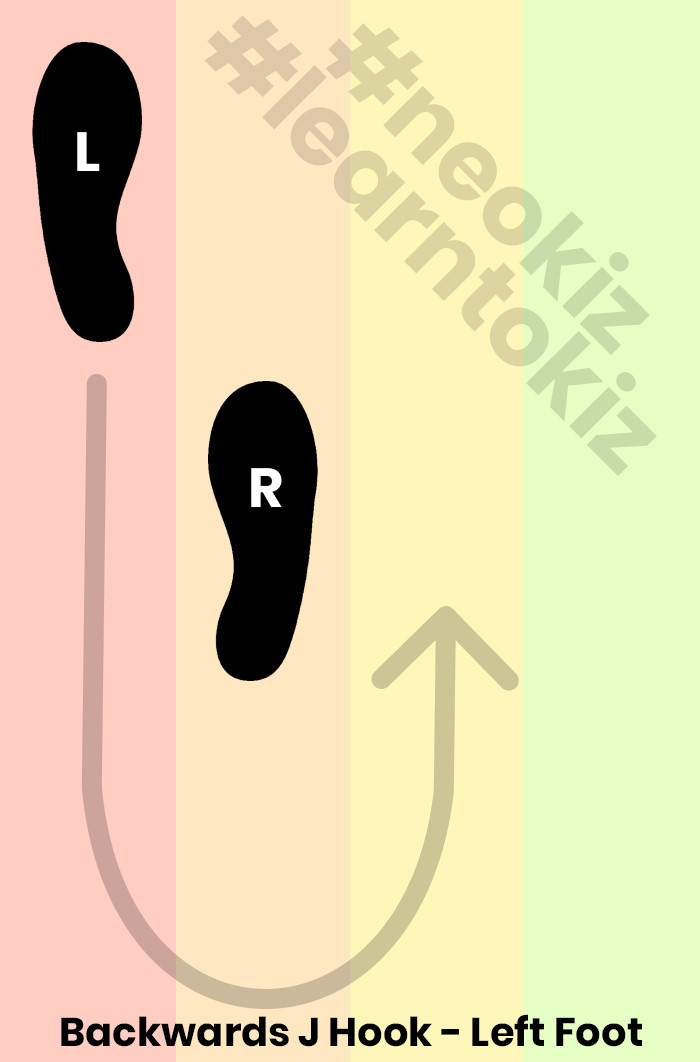 Left Foot Backwards – J hook step
Left Foot Backwards – J hook step
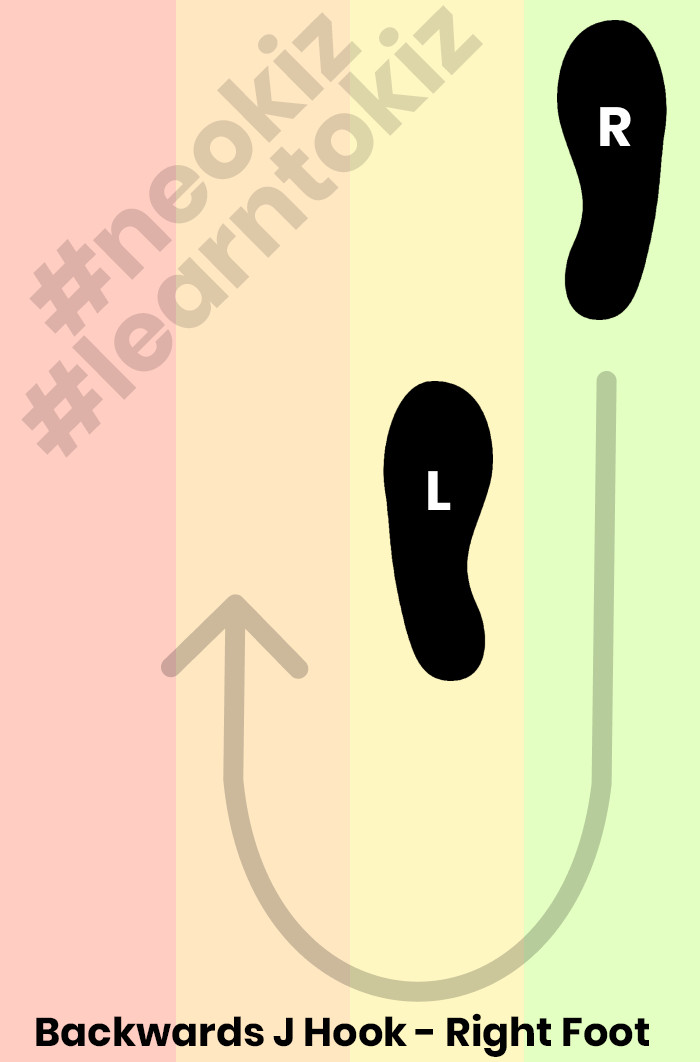 Right Foot Backwards – J hook step
Right Foot Backwards – J hook step
9. Why Are These Variations Important?
Why is it crucial to understand all these hook step variations? Understanding all variations of hook steps provides a solid foundation for developing your dancing skills further. Mastering these steps allows for greater adaptability and creativity on the dance floor. According to renowned Urbankiz instructor Ricardo Sousa, “A dancer’s ability to seamlessly integrate hook steps into their movements is what sets them apart.”
- Adaptability: Easily adjust to different music and partner styles.
- Creativity: Develop unique and personalized dance sequences.
- Mastery: Achieve a higher level of skill and confidence in Urbankiz.
10. Real-World Applications of Hook Steps
How can you apply these hook steps in a practical dance setting? Hook steps are used in various Urbankiz sequences and combinations, adding flair and complexity to social dancing and choreographed routines.
- Social Dancing: Impress partners with smooth and stylish moves.
- Choreography: Create visually stunning and complex routines.
- Performance: Enhance stage presence and captivate audiences.
11. Essential Tips for Mastering Hook Steps
What are some essential tips for learning and perfecting hook steps? Focus on rhythm, posture, and connection with your partner to execute hook steps effectively. Practicing with a mirror and seeking feedback from instructors can also improve your technique.
- Rhythm: Maintain a consistent beat and tempo.
- Posture: Keep your core engaged and back straight.
- Connection: Maintain a strong connection with your dance partner.
12. Common Mistakes to Avoid in Hook Steps
What common mistakes should dancers avoid when practicing hook steps? Avoid rushing the steps, losing balance, or neglecting connection with your partner. Proper technique and mindful practice are key to avoiding these pitfalls.
- Rushing: Take your time to execute each step accurately.
- Balance: Maintain stability by engaging your core.
- Connection: Stay connected with your partner throughout the dance.
13. Integrating Hook Steps into Your Dance Style
How can you seamlessly integrate hook steps into your existing dance style? Start by practicing basic hook steps in isolation, then gradually incorporate them into simple sequences. Experiment with variations and styling to personalize your movements.
- Practice: Start with basic steps and gradually increase complexity.
- Experiment: Explore different variations and styling options.
- Personalize: Adapt the steps to fit your unique dance style.
14. The Role of Footwork in Hook Steps
Why is footwork so important in executing hook steps? Proper footwork is crucial for maintaining balance, rhythm, and fluidity in hook steps. Pay attention to the placement, weight transfer, and timing of each foot movement.
- Placement: Ensure your feet are positioned correctly for each step.
- Weight Transfer: Shift your weight smoothly and efficiently.
- Timing: Execute each step in time with the music.
15. Enhancing Musicality with Hook Steps
How do hook steps enhance musicality in Urbankiz? Hook steps allow dancers to express the nuances of the music, adding layers of rhythm and emotion to their movements. By varying the speed, timing, and styling of hook steps, dancers can create a dynamic and engaging performance.
- Vary Speed: Adjust the tempo of your steps to match the music.
- Change Timing: Experiment with different rhythmic patterns.
- Add Emotion: Infuse your movements with feeling and expression.
16. The Significance of Partner Connection in Hook Steps
Why is partner connection essential when performing hook steps? Maintaining a strong connection with your partner is crucial for leading and following hook steps effectively. Clear communication, mutual understanding, and responsiveness are key to creating a harmonious dance experience.
- Communication: Clearly signal your intentions to your partner.
- Understanding: Anticipate your partner’s movements.
- Responsiveness: React quickly and smoothly to your partner’s cues.
17. Advanced Techniques: Styling and Embellishments
What are some advanced techniques for styling and embellishing hook steps? Experiment with arm styling, body movements, and facial expressions to add personality and flair to your hook steps. Incorporate isolations, contra-body movement, and other advanced techniques to create a visually stunning performance.
- Arm Styling: Add graceful and expressive arm movements.
- Body Movements: Incorporate hip movements, shoulder shakes, and other body isolations.
- Facial Expressions: Use your face to convey emotion and connect with the audience.
18. Staying Safe: Avoiding Injuries with Hook Steps
How can you avoid injuries while practicing hook steps? Proper warm-up, cool-down, and stretching are essential for preventing injuries. Listen to your body and avoid pushing yourself too hard, especially when learning new steps.
- Warm-Up: Prepare your muscles and joints for activity.
- Cool-Down: Gradually decrease your heart rate and relax your muscles.
- Stretching: Improve flexibility and range of motion.
19. Finding Inspiration: Watching Professional Performances
Where can you find inspiration for incorporating hook steps into your dance? Watching professional Urbankiz dancers perform can provide inspiration and insight into advanced techniques and styling options. Attend live performances, watch online videos, and study the movements of renowned dancers.
- Live Performances: Experience the energy and excitement of live dance.
- Online Videos: Access a wealth of instructional and performance videos.
- Renowned Dancers: Study the techniques and styles of top performers.
20. The Future of Hook Steps in Urbankiz
How are hook steps evolving in the world of Urbankiz? As Urbankiz continues to evolve, so too will the use of hook steps. Dancers are constantly experimenting with new variations, styling options, and combinations, pushing the boundaries of this dynamic dance style.
- Innovation: Embrace new ideas and approaches to hook steps.
- Experimentation: Try different techniques and combinations.
- Collaboration: Share ideas and learn from other dancers.
21. Hook Steps and the Six Lanes of Partnership
How do hook steps relate to the concept of six lanes in Urbankiz partnership? The six lanes provide a framework for understanding movement and connection between partners. Hook steps can be used to navigate these lanes, creating dynamic and visually interesting patterns.
- Understanding Lanes: Familiarize yourself with the concept of six lanes.
- Navigating Movement: Use hook steps to move between lanes.
- Creating Patterns: Develop visually appealing dance sequences.
22. Hook Steps as an Extension of Saídas
In what way are hook steps an extension of the foundational Saídas in Urbankiz? Saídas are fundamental steps that involve moving in and out of different positions. Hook steps can be incorporated into Saídas to add complexity and flair, enhancing the overall dance experience.
- Mastering Saídas: Ensure a strong foundation in basic Saídas.
- Adding Complexity: Incorporate hook steps to enhance Saídas.
- Enhancing Experience: Create more engaging and dynamic dances.
23. Common Leading Mistakes in Hook Steps
What mistakes do leaders often make when leading hook steps, and how can they be avoided? Leaders should focus on clear communication, precise timing, and maintaining a solid connection with their partner. Avoid rushing the steps or providing ambiguous cues.
- Clear Communication: Use clear and concise signals.
- Precise Timing: Ensure accurate timing of the lead.
- Solid Connection: Maintain a strong connection with the follower.
24. Common Following Mistakes in Hook Steps
What are typical mistakes that followers make when responding to hook step leads? Followers should focus on responsiveness, anticipation, and maintaining a strong connection with the leader. Avoid overthinking the steps or anticipating the lead incorrectly.
- Responsiveness: React quickly and smoothly to the lead.
- Anticipation: Anticipate the leader’s movements accurately.
- Strong Connection: Maintain a strong connection with the leader.
25. How to Practice Hook Steps Solo
What are effective ways to practice hook steps when you don’t have a partner? Practicing in front of a mirror, using online tutorials, and focusing on rhythm and footwork can improve your technique and build muscle memory.
- Mirror Practice: Use a mirror to check your form and technique.
- Online Tutorials: Follow instructional videos to learn new steps.
- Rhythm and Footwork: Focus on precise timing and foot placement.
26. The Importance of Body Awareness in Hook Steps
Why is body awareness crucial for executing hook steps correctly and safely? Understanding your body’s position, balance, and movement is essential for executing hook steps effectively and avoiding injuries.
- Position: Know where your body is in space.
- Balance: Maintain stability and control.
- Movement: Move with fluidity and precision.
27. Hook Steps in Different Urbankiz Styles
How do hook steps vary across different styles within Urbankiz? Different Urbankiz styles, such as Fusion, Authentic, and Tarraxinha, may incorporate hook steps in unique ways. Understanding these variations can enhance your versatility as a dancer.
- Fusion: Combines Urbankiz with other dance styles.
- Authentic: Focuses on traditional Urbankiz movements.
- Tarraxinha: Emphasizes close connection and sensual movements.
28. Hook Steps and Floor Craft: Navigating the Dance Floor
How do hook steps help in navigating the dance floor effectively? Hook steps can be used to change direction, avoid collisions, and create visually interesting patterns on the dance floor.
- Changing Direction: Use hook steps to turn and move in different directions.
- Avoiding Collisions: Steer clear of other dancers.
- Creating Patterns: Design visually appealing movements on the floor.
29. Hook Steps as a Tool for Improvisation
How can hook steps be used as a tool for improvisation in Urbankiz? Mastering hook steps provides a vocabulary of movements that can be used to improvise and create unique dance sequences on the spot.
- Building Vocabulary: Learn a range of hook step variations.
- Creating Sequences: Combine steps to form improvised routines.
- Expressing Creativity: Use improvisation to express your unique style.
30. Advanced Drills for Hook Step Mastery
What are some advanced drills that can help in mastering hook steps? Repetition drills, speed drills, and variation drills can improve your technique, speed, and adaptability.
- Repetition Drills: Practice basic steps repeatedly.
- Speed Drills: Increase the tempo of your steps.
- Variation Drills: Experiment with different styles and combinations.
31. Hook Steps and the Connection to Music Theory
How does understanding music theory enhance the execution of hook steps? Understanding musical concepts like rhythm, tempo, and phrasing can improve your timing and musicality when performing hook steps.
- Rhythm: Maintain a consistent beat and tempo.
- Tempo: Adjust the speed of your steps to match the music.
- Phrasing: Align your movements with the musical phrases.
32. Integrating Arm Styling with Hook Steps
How can arm styling be effectively integrated with hook steps to enhance performance? Coordinating arm movements with hook steps can add grace, expression, and visual appeal to your dance.
- Coordination: Synchronize arm movements with footwork.
- Expression: Use arms to convey emotion and enhance the story.
- Visual Appeal: Create visually stunning and dynamic movements.
33. The Use of Contra-Body Movement in Hook Steps
How does contra-body movement enhance the dynamics of hook steps? Contra-body movement involves rotating the torso in opposition to the hips and legs, adding depth, complexity, and visual interest to hook steps.
- Rotation: Rotate the torso to create dynamic movements.
- Complexity: Add layers of depth to your dance.
- Visual Interest: Enhance the visual appeal of your performance.
34. Hook Steps and the Concept of Flow
How do hook steps contribute to creating a sense of flow in Urbankiz? Hook steps can be seamlessly integrated into sequences to create a continuous, fluid, and visually appealing dance experience.
- Seamless Integration: Blend hook steps into your dance sequences.
- Fluid Movement: Maintain a continuous and graceful flow.
- Visual Appeal: Create a captivating dance experience.
35. The Psychological Benefits of Mastering Hook Steps
What are the psychological benefits of mastering complex dance elements like hook steps? Mastering challenging dance elements can boost confidence, improve cognitive function, and provide a sense of accomplishment.
- Confidence: Build self-esteem and assurance.
- Cognitive Function: Enhance mental agility and coordination.
- Accomplishment: Experience a sense of achievement and satisfaction.
36. Hook Steps and Cultural Context in Urbankiz
How do cultural elements influence the way hook steps are performed in Urbankiz? Urbankiz is influenced by various cultures, and understanding these influences can add depth and authenticity to your dance.
- Cultural Influences: Explore the cultural roots of Urbankiz.
- Authenticity: Perform hook steps in a way that honors the tradition.
- Depth: Add layers of meaning and emotion to your dance.
37. Combining Hook Steps with Other Dance Styles
How can hook steps be combined with elements from other dance styles? Experimenting with fusion can create unique and innovative dance styles that blend the best of different worlds.
- Fusion: Combine Urbankiz with other dance forms.
- Innovation: Create new and exciting dance styles.
- Versatility: Expand your range as a dancer.
38. The Ethical Considerations in Teaching Hook Steps
What are the ethical considerations for instructors teaching hook steps in Urbankiz? Instructors should prioritize safety, inclusivity, and respect for the dance’s cultural origins.
- Safety: Ensure students learn proper technique to avoid injuries.
- Inclusivity: Create a welcoming and supportive learning environment.
- Respect: Honor the cultural roots and traditions of Urbankiz.
39. The Business of Hook Steps: Workshops and Classes
How can understanding hook steps contribute to success in the dance business? Offering specialized workshops and classes on hook steps can attract students and enhance your reputation as an instructor.
- Specialization: Focus on teaching specific techniques.
- Attraction: Draw in new students with specialized classes.
- Reputation: Enhance your credibility as an instructor.
40. Continuing Education: Staying Updated on Hook Step Techniques
How can dancers and instructors stay updated on the latest trends and techniques in hook steps? Attend workshops, follow online resources, and engage with the Urbankiz community to stay informed and continue learning.
- Workshops: Attend classes led by experienced instructors.
- Online Resources: Follow blogs, videos, and social media accounts.
- Community Engagement: Connect with other dancers and instructors.
Unlocking the 12 basic hook step entries in Urbankiz provides a solid foundation for developing your dance skills further, enhancing your adaptability, creativity, and overall mastery of Urbankiz. Embrace these variations to elevate your dance experience, whether on the social dance floor or in choreographed performances.
Ready to take your Urbankiz to the next level? Explore the comprehensive resources at ten-dance.com. From detailed tutorials to a vibrant community of dancers, we have everything you need to master hook steps and more. Join us today and discover the joy of dance! Visit learntokiz.com for more videos breaking down the nuances of these hook steps with drills and partnerwork steps.
Address: 60 Lincoln Center Plaza, New York, NY 10023, United States
Phone: +1 (212) 769-7000
Website: ten-dance.com
FAQ: Hook Steps in Dance
What is a hook step in dance?
A hook step involves hooking one foot around or behind the other while transferring weight, commonly used in Urbankiz to enhance musicality and fluidity.
How many types of hook steps are there?
There are 12 basic hook step entries, categorized into Rectangle (R), V, and J, each with forward and backward variations.
What is a Rectangle (R) hook step?
A Rectangle hook step involves two touches before executing the hook, creating a square-like pattern on the dance floor.
What is a V hook step?
A V hook step includes one touch before moving into the hook, creating a dynamic and sharp movement.
What is a J hook step?
A J hook step involves no touches before the hook, providing a direct and fluid movement.
Why is partner connection important in hook steps?
Maintaining a strong connection is crucial for leading and following hook steps effectively, ensuring clear communication and harmonious movement.
How can I practice hook steps solo?
Practice in front of a mirror, use online tutorials, and focus on rhythm and footwork to improve technique and build muscle memory.
What are common mistakes to avoid in hook steps?
Avoid rushing steps, losing balance, or neglecting partner connection. Proper technique and mindful practice are key.
How do hook steps enhance musicality?
Hook steps allow dancers to express nuances in music, adding layers of rhythm and emotion to movements by varying speed, timing, and styling.
Can hook steps be combined with other dance styles?
Yes, experimenting with fusion can create unique and innovative dance styles, blending the best of different worlds.

